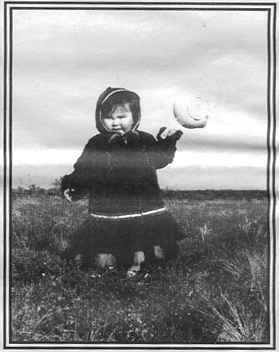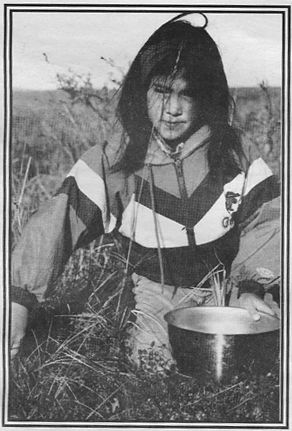Ilitqusiat is “the way
people are.” Their spiritual characteristics motivate
their attitudes and actions. Inupiat ilitqusiat actually means “how
the Eskimo are.” Your ilitqusiq is motivated by your
spirit: happy spirit, sad spirit, fighting spirit, calm spirit.
Rachel
Craig
Kotzebue Elder

Roughing It Along The Kobuk
Gary Tickett
Shungnak
Mt. Edgecumbe High School
“ Berry picking is thrilling
but it takes a long time to fill a five gallon bucket.”
Gary Tickett

“
Sometimes we catch fish as long as a five-year-old kid,” said
Christopher Tickett, a member of the younger generation of
the Tickett family.
Subsistence camps have been a part of his
life as far back as he can remember. Every summer he travels
with his family
to their
subsistence camp to gather and prepare supplies for the coming
year. Camps are
an extremely meaningful part of the Tickett family’s
traditions—past, present and future.
The grandparents
of the Tickett children of this generation were shaped by
the environment in which they were raised.
Aliqsi (Wilson
Tickett) was thrust into the world in the small village of
Qala, located approximately 35 miles up the Kobuk River from
Shungnak.
He was raised along the river by his parents, Paul and Iyagaaluk
Tickett.
In 1920, a sweet lovable baby, named Daisy Stocking
(Tickett), was born at a camp along the Pah River, bringing
joy to the
family The camp was located approximately 70 miles up the
Kobuk River
from Shungnak.
Daisy was raised along the Kobuk River by her
parents, Naaluniaq White and Suzie Stocking. Going to school
was a hardship
for Wilson and Daisy because it took away time spent doing
daily
chores like
hunting, fishing and berry picking. Also, they frequently
traveled to other camps because of the weather that varies
throughout
the seasons of the year.
As the years passed, the only English
they learned was from their children who went to school.
The environment was the
main influence
on the lives of our ancestors during their formative years.
The
history of subsistence camp is highly important to the Tickett
family. Maniilapiat camp is well located on the Maniilaq
River,
for use by the Tickett family. It’s right below the
Brooks Range and above the Arctic Circle.
There is a great
amount of fish including grayling, pike,
white fish, salmon, sheefish, mudshark and trout. The area
game includes
moose,
muskox, caribou, reindeer, wolves, wolverine, lynx, fox,
martin, otter, beaver, muskrat, swan, geese and ducks.
There
is also an abundance of blueberries, salmonberries, blackberries,
cranberries and raspberries. My great grandparents
were aware
that their survival depended on subsistence gathering. There
were no
supermarkets. The food that was available was expensive.
Fishing, hunting
and collecting berries were the most important work for them.
Every
summer, subsistence camp is a pleasure and necessity for
the Tickett family. The Ticketts still go to camp but
not as
much as in the past. They went as soon as the ice was gone
and stayed until it formed again, that was about four to
five months.
Now they
go at the warmest part of the summer for about two months
in June and July.
Modern transportation to camp is much easier
today than in the past. Wooden kayaks are no longer used
because store
bought or
homemade
boats are affordable.
There are three main things to do at
camp—fishing, hunting
and picking berries. They catch their fish by netting, seining
and hook and lining. They bring the fish back to camp and
either put
them in bags and send them down to Shungnak to freeze, or
cut the fish into strips, dry and store them away for the
winter.
 Berry picking is thrilling but it takes a long time
to fill a five gallon bucket.
Berry picking is thrilling but it takes a long time
to fill a five gallon bucket.
The enjoyment part of camp is
when we are fishing, hunting and going to bed. Seining and
lining the fish is the most
fun for
the Tickett
children. They say when pulling on a rope of a seining net
it’s
like a challenge in a tug of war game.
Hiking on mountains,
behind their camp, or up and down river while hunting is
tiring but enjoyable for them. While they
are on their
hike and there is nothing around, they sometimes get bored.
When they have a .22 long rifle with extra shells to waste,
they hang
an empty soda can on a bush and target practice.
At night,
when the adults tell them it’s time for bed, they
start whining because they do not want to end their excitement
out in the trees. The adults always win and they have to
be in bed by
11 o’clock.
But, the excitement doesn’t really
end there. The children wait til the adults go to sleep,
then they start talking about stupid
and silly things they did in their past, until 3 o’clock
in the morning.
The living arrangements at camp are comfortable
but different from home. There is one big cabin for the
children with no
rooms and
no privacy. There are two big Carhart tents for the adults.
Since there is no electricity at their camp, they use lanterns,
candles,
flashlights and open woodstoves for their light in the
dark.
The hope for the future of the camp is that it will
be culturally pure for the next generations as it is today
and was yesterday.
One of the main concerns of the Tickett family is that
the quality of, fishing remain constant. They want to
have the
same great
tasting fish in the future for potlatches, holidays and
something to feed pets.
The Tickett family members have
made it their lifelong goal to ensure the children enjoy
subsistence camp with
all the
enthusiasm,
pleasure
and pride of past generations.